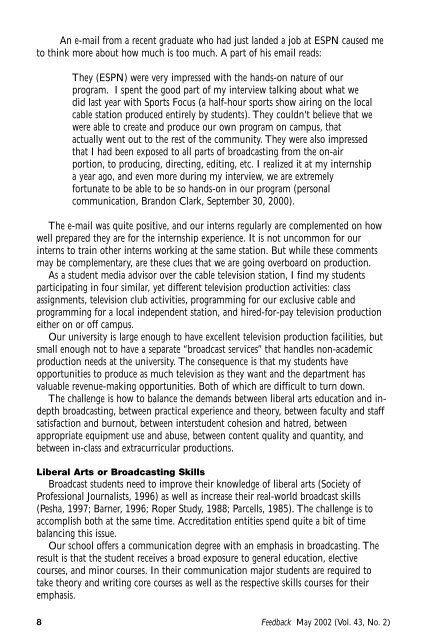Feedback May 2002 (Vol 43 No 2)
Feedback May 2002 (Vol. 43, No. 2) - Broadcast Education ...
Feedback May 2002 (Vol. 43, No. 2) - Broadcast Education ...
- No tags were found...
You also want an ePaper? Increase the reach of your titles
YUMPU automatically turns print PDFs into web optimized ePapers that Google loves.
An e-mail from a recent graduate who had just landed a job at ESPN caused meto think more about how much is too much. A part of his email reads:They (ESPN) were very impressed with the hands-on nature of ourprogram. I spent the good part of my interview talking about what wedid last year with Sports Focus (a half-hour sports show airing on the localcable station produced entirely by students). They couldn't believe that wewere able to create and produce our own program on campus, thatactually went out to the rest of the community. They were also impressedthat I had been exposed to all parts of broadcasting from the on-airportion, to producing, directing, editing, etc. I realized it at my internshipa year ago, and even more during my interview, we are extremelyfortunate to be able to be so hands-on in our program (personalcommunication, Brandon Clark, September 30, 2000).The e-mail was quite positive, and our interns regularly are complemented on howwell prepared they are for the internship experience. It is not uncommon for ourinterns to train other interns working at the same station. But while these commentsmay be complementary, are these clues that we are going overboard on production.As a student media advisor over the cable television station, I find my studentsparticipating in four similar, yet different television production activities: classassignments, television club activities, programming for our exclusive cable andprogramming for a local independent station, and hired-for-pay television productioneither on or off campus.Our university is large enough to have excellent television production facilities, butsmall enough not to have a separate “broadcast services” that handles non-academicproduction needs at the university. The consequence is that my students haveopportunities to produce as much television as they want and the department hasvaluable revenue-making opportunities. Both of which are difficult to turn down.The challenge is how to balance the demands between liberal arts education and indepthbroadcasting, between practical experience and theory, between faculty and staffsatisfaction and burnout, between interstudent cohesion and hatred, betweenappropriate equipment use and abuse, between content quality and quantity, andbetween in-class and extracurricular productions.Liberal Arts or Broadcasting SkillsBroadcast students need to improve their knowledge of liberal arts (Society ofProfessional Journalists, 1996) as well as increase their real-world broadcast skills(Pesha, 1997; Barner, 1996; Roper Study, 1988; Parcells, 1985). The challenge is toaccomplish both at the same time. Accreditation entities spend quite a bit of timebalancing this issue.Our school offers a communication degree with an emphasis in broadcasting. Theresult is that the student receives a broad exposure to general education, electivecourses, and minor courses. In their communication major students are required totake theory and writing core courses as well as the respective skills courses for theiremphasis.8<strong>Feedback</strong> <strong>May</strong> <strong>2002</strong> (<strong>Vol</strong>. <strong>43</strong>, <strong>No</strong>. 2)
















